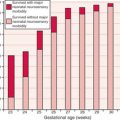CHAPTER 16 Anaemia and blood product transfusions
Anaemia of prematurity
The clinical effects of anaemia include:
When recovery from anaemia of prematurity occurs, iron stores are depleted quickly. Iron treatment is used to aid recovery from anaemia of prematurity (see page 76).
Top-up transfusion
• Blood for neonatal ‘top-up’ transfusions is supplied in paediatric packs (paed packs). A single unit of donor RBC is split into 4 packs averaging ∼50 mL (25–100 mL). When a baby uses one of the 4 packs, the other 3 may be set aside for possible future use in that baby, thus limiting the number of donors the baby may be exposed to.
• The blood supplied in the paed packs has a haematocrit of about 0.6 (0.5–0.7). The blood is filtered to remove 99.998% of white cells, and irradiated.
• Indications:
Platelets
• Give a platelet transfusion if the platelet count is <25 × 109/L. Always get consent for transfusion from parents before administering, and note this in the chart.
• Platelet transfusion may be required at higher platelet counts if there is bleeding or the baby requires surgery or other vascular procedures (e.g. central venous line insertion).
Albumin
The use of albumin infusions for infants with hypoalbuminaemia is controversial.
• Many ELBW infants (especially those whose main nutrition source is parenteral) do not make albumin well. It is these infants who some believe may benefit from an albumin infusion if the serum albumin is <25 g/L.
• An infusion of albumin may increase intravascular volume. This may lead to cardiovascular compromise if the albumin is infused too quickly.
Some clinicians would give frusemide half-way through the infusion to pre-empt this.
• Beware if there are leaky capillaries, as one might see in babies with capillary leak syndrome (CLS) secondary to septicaemia or trauma/surgery. Any infused albumin will leak into the tissues, osmotically dragging fluid with it — making any oedema worse. This may also deplete intravascular volume.




